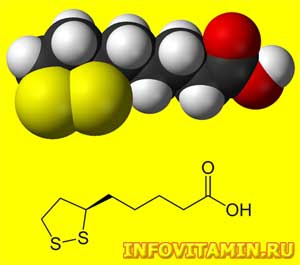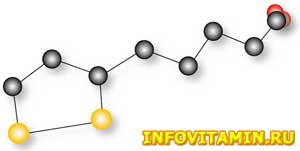Alpha-lipoic acid — description, properties, application, contraindications
Thioctic acid
Alpha-lipoic acid relieves peripheral neuropathy in diabetic patients. Acting as a powerful antioxidant, this dietary supplement protects liver and brain cells, prevents cataracts.
What is alpha lipoic acid — description
|
Since the 1950s, it has been known that alpha-lipoic acid (sometimes called simply lipoic, or thioctic) is necessary for the work of enzymes that break down in cells organic substances with the release of energy. At the end of the 1980s, this vitamin-like compound revealed the properties of a powerful antioxidant, i. e. the ability to neutralize aggressive oxidants, the so-called free radicals, harmful to the body, but continuously formed in it. Although lipoic acid is produced by our cells, we get its main amounts from food, primarily from spinach, meat, liver, brewer's yeast. It is difficult to provide therapeutic doses in this way, so it is advisable for some people to take her medications.
| Do you know? |
| Injections of alpha-lipoic acid were used to save the lives of people poisoned by poisonous mushrooms of the genus Amanita (fly agaric, pale toadstool). |
Useful properties of alpha-lipoic acid
Lipoic acid works in all our cells. Together with B vitamins, including thiamine, riboflavin, pantothenic acid and niacin, it is involved in obtaining energy from proteins, fats and carbohydrates. By itself showing antioxidant properties, it also helps to restore the activity of other antioxidants, such as vitamins C and E, i. e. enhances their beneficial effects. Lipoic acid is easily absorbed by most of our tissues, including nerves, brain and liver.
The main use of alpha-lipoic acid
One of the main indications for taking lipoic acid is nervous disorders, primarily diabetic neuropathy, i. e. a complication of diabetes mellitus, which is manifested by pain in the extremities and a decrease in their sensitivity.
|
Perhaps this condition is partly due to the damage of nerve cells by free radicals, which is facilitated by an increased level of glucose in the blood. Therefore, the benefit of lipoic acid in this case is explained by its antioxidant properties. In addition, it increases sensitivity to insulin, a hormone necessary for glucose uptake by cells. In one study, daily intake of at least 600 mg of lipoic acid by 74 patients with type II diabetes in all cases led to a decrease in blood glucose levels. Animal experiments also show that alpha-lipoic acid improves blood supply to nerves and enhances the conduction of nerve impulses. This explains its benefits for symptoms such as numbness, tingling and other sensitivity disorders of any, not only diabetic etiology.
More lipoic acid protects the liver from free radicals, and as a result accelerates the purification of the body from toxins. Sometimes it is prescribed for hepatitis, cirrhosis and other liver pathologies, lead poisoning, as well as other heavy metals and industrial pollutants, such as carbon tetrachloride.
Additional benefits
The use of lipoic acid in other disorders requires additional study. Animal experiments say that it prevents the development of cataracts, and also possibly improves memory (this is useful, for example, in Alzheimer's disease) and protects the brain from the consequences of insufficient blood supply (stroke, surgery).
According to some reports, the antioxidant properties of alpha-lipoic acid contribute to the suppression of viral infections. In one study, its supplements boosted immunity and improved liver function in AIDS patients. Perhaps it protects against cancer, primarily caused by damage to cells by free radicals. Obviously, lipoic acid also inhibits the development of atherosclerosis, to which diabetics are especially predisposed. Its effectiveness in Alzheimer's disease and Parkinsonism is being investigated. In principle, as a powerful antioxidant, it should help with any conditions, the development of which is promoted by free radicals, from chronic fatigue syndrome to psoriasis.
Indications for the use of alpha-lipoic acid
• Diabetic neuropathy: tingling, numbness, other unpleasant sensations in the extremities
• Protection of the liver in hepatitis, alcoholism, poisoning, exposure to environmental pollutants
• Cataract prevention
• Memory protection in Alzheimer's disease
• A wide range of pathologies associated with exposure to free radicals and weakening of the immune system, including AIDS, psoriasis, chronic fatigue syndrome.
Methods of application of alpha-lipoic acid
• Doses
For specific disorders: usually 100-200 mg is recommended three times a day. For general antioxidant effect: 50-150 mg/day.
• Reception scheme
It can be taken both at meals and at other times.
| Caution! |
| If you are being treated with medications, take any medications only with the permission of a doctor. |
Release form
• Tablets
• Capsules
| Your choice |
| Alpha-lipoic acid is sold as a separate preparation or a combined antioxidant supplement in combination with vitamins C and E and other substances. In the list of ingredients, it may appear as thioctic acid. |
Contraindications to the use of alpha-lipoic acid
• Diabetic patients should take alpha lipoic acid only under the supervision of a doctor.
| Latest news |
| For three weeks, 328 patients with diabetic neuropathy were given 100, 600 or 1200 mg of alpha-lipoic acid daily. In the group receiving 600 mg / day, the maximum relief of pain and numbness of the extremities was observed. Alpha-lipoic acid can help 25% of diabetic patients with an increased risk of sudden death from neurogenic cardiopathy. After four months of taking 800 mg of this substance daily, the patients' cardiac function improved. |
Possible side effects when using lipoic acid
There were no serious problems with the use of lipoic acid. Mild stomach disorders are possible, in rare cases allergic rash. If a side effect is suspected, it is recommended to reduce the dose or stop taking alpha-lipoic acid altogether.
To the section «Food additives — descriptions, properties and applications»
•••••••••


